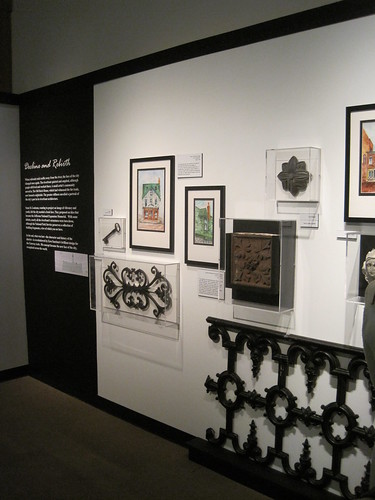by Michael R. Allen
 Photograph of St. Louis riverfront buildings from the Historic American Buildings Survey.
Photograph of St. Louis riverfront buildings from the Historic American Buildings Survey.
The nation’s only urban national park, the Jefferson National Expansion Memorial with the stunning Gateway Arch by Eero Saarinen, has long been haunted by a shadow architectural history. To make way for one of the world’s most full-realized modernist landscapes, St. Louis wrecked forty blocks of historic riverfront buildings. The significance of these buildings in American architectural history was such that in 1939, eminent architectural critic and historian Siegfried Gideon came to St. Louis to deliver a lecture on the doomed buildings. Gideon not only spoke about the unparalleled mass of cast-iron facades and storefronts found on the riverfront, he implored the city to change course and preserve the riverfront’s commercial buildings.
 Gideon’s cry went unheeded, and plans to create a national memorial to westward expansion on the St. Louis riverfront progressed. Fortunately, the memorial’s architectural achievement matched what was lost. Still, the memorial site has a psychological scar tissue to any who know what was lost there. The National Park Service has had some difficulty in interpreting the pre-memorial riverfront so that both the memorial and the prior riverfront architecture are suitably honored.
Gideon’s cry went unheeded, and plans to create a national memorial to westward expansion on the St. Louis riverfront progressed. Fortunately, the memorial’s architectural achievement matched what was lost. Still, the memorial site has a psychological scar tissue to any who know what was lost there. The National Park Service has had some difficulty in interpreting the pre-memorial riverfront so that both the memorial and the prior riverfront architecture are suitably honored.
Thus, the current “Faces of the Riverfront” exhibit at the Old Courthouse is a welcome endeavor, and, given current events, quite timely and inspirational. (The exhibit runs through August 22, through the unveiling of designs by finalists in the current design competition.) The National Park Service gave artist Sheila Harris access to its extensive photographic record of riverfront buildings lost to build the memorial, and she painted in watercolor renderings of the documented buildings. Harris’ paintings transform the hard, stoic documentation taken before the riverfront death knell into soft, humane snapshots of a still-living urban landscape.
 Sheila Harris speaks at the exhibit’s opening reception on February 14th.
Sheila Harris speaks at the exhibit’s opening reception on February 14th.
 Alongside the paintings are rarely-seen items from the Memorial’s collection of salvaged portions of riverfront buildings. Those who have seen the items on permanent display in the Old Courthouse often wonder what else remains, and here are a few answers. The expected cast iron pieces are joined by a more obscure terra cotta piece. The only problem withFaces of the Riverfront is that the fragments and watercolors pique a visitor’s interest in seeing the source photographs, of which none are on display save as wall-sized backdrops. Perhaps those photographs will be made public as part of a future Memorial project.
Alongside the paintings are rarely-seen items from the Memorial’s collection of salvaged portions of riverfront buildings. Those who have seen the items on permanent display in the Old Courthouse often wonder what else remains, and here are a few answers. The expected cast iron pieces are joined by a more obscure terra cotta piece. The only problem withFaces of the Riverfront is that the fragments and watercolors pique a visitor’s interest in seeing the source photographs, of which none are on display save as wall-sized backdrops. Perhaps those photographs will be made public as part of a future Memorial project.
3 replies on “National Park Service Sponsors Look at Lost Riverfront Architecture”
Even if they had put the Arch amid a field of buildings, they would never have survived the decades of obsession with clearing "views" and "green space". The same mania that claimed every building in the Gateway Mall would have killed the 40 blocks sooner or later.
I agree, I believe in preservation. that’s one reason Peoria has gone down in the decades.
The majority of the images are available through http://www.loc.gov in the Historic American Buildings Survey Collection. Credit for this exhibit is also due to the exhibit team: Beth Browne – Designer, Terry Weber – construction and installation, and Sue Ford – construction and installation.